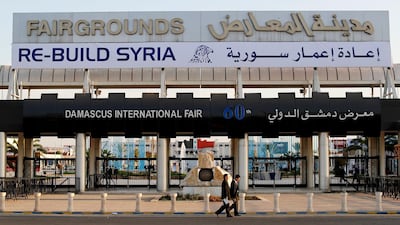Iran and Syria have inked a deal to build a $460 million (Dh 1.7 billion) power plant in the regime stronghold coastal area of Latakia in a move seen as a deepening of Tehran’s economic influence in the shattered country.
With Western powers refusing to contribute to the reconstruction of Syria without meaningful political transition, Damascus is looking to Iran, Russia and China for assistance in rebuilding the shattered infrastructure of the country. With direct government funding unlikely in sufficient quantities to raise the hundreds of billions the International Monetary Fund estimate is needed to fix the country, private investment will be key.
After pouring money into backing the regime of Bashar Al Assad militarily, Iran is now looking to reap the benefit of their increased influence in Damascus.
Iran's Minister of Energy Reza Ardakanian was quoted as saying by the semi-official ISNA news agency that a memorandum of understanding was signed on Tuesday.
State news agency IRNA reported that the MoU was signed by the head of the Iranian power and infrastructure group MAPNA and the head of the Syrian public authority for electricity generation.
The project is slated to begin next year.
______________
Read more:
Russia, India to sign deal on S-400 air defence systems this week: Kremlin
Idlib deal a step forward but Syria quagmire far from resolved
September saw lowest civilian casualty of Syrian war
______________
"Iranian private firms are keen to participate in energy projects in Syria and reconstruct its electricity grid," Mr Ardakanian said.
In 2017, Iran and Syria signed an agreement to repair Syria's power grid. The agreement involved restoring the main control centre for Syria's electricity network in the capital Damascus.
While in some areas of the country taken by rebel and extremist groups the government continued to supply power, there are reports that residents in recaptured towns have now been ordered to back pay the government even when services were not provided or where they paid local militias or the armed group in control of the area of supply.
Mr Ardakanian said he was hopeful that a second credit line would be launched between the two countries.
Tehran opened a $3.5 billion credit line in 2013, and extended it by $1 billion in 2015, which economists say has helped keep the Syrian economy afloat.
Despite the battered power network struggling to meet national demand, in August 2017 Syria made a deal with neighbouring Lebanon to sell the notoriously power-starved Electricite Du Liban 300 megawatts of electricity. This boosted the existing 90 MW of power by 210 MW, Lebanese Finance Minister Ali Hasan Khalil said at the time.
Lebanon has not been able to provide 24-hour power to the entire country since the end of the civil war in 1990 and while most of Beirut suffers at least 3-hour power outages a day, outside the capital cuts are significantly longer.

